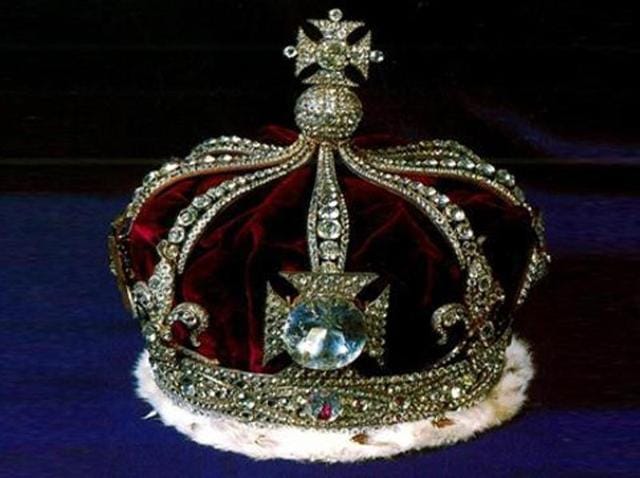Virendra Pandit
New Delhi: The controversial Indian diamond Koh-e-Noor (Hill of Light), which some believe is unlucky and has destroyed its owners’ reigns, will now be part of the Crown of the new British Queen Consort, Camilla.
Her predecessor Queen Elizabeth II once remarked it is too heavy to wear!
According to a 2018 BBC documentary, Queen Elizabeth II said not only is the Crown studded with Koh-e-Noor very difficult to balance, but it could ‘break her neck’ if she looked down.
The British media reported that Queen Consort Camilla will have Elizabeth II’s priceless platinum and diamond Crown placed on her in a ceremony during King Charles III’s coronation in the coming weeks.
The Koh-i-Noor is viewed as the world’s bloodiest and most infamous diamond. The 105.6 carats dazzling diamond, with controversial origins and history, is now one of 2,800 diamonds, along with sapphires and other precious stones, in the Britain monarch’s Crown crafted in 1937.
When Queen Camilla joins King Charles III during his coronation, they will crown her with Koh-e-Noor and other diamonds. The media based these reports on a message published on the eve of Queen Elizabeth’s 70th accession in February 2022, in which she said it was her “sincere wish” that Charles’s wife would be known on his accession to the throne as Queen Consort.
Historical records say the Koh-e-Noor, originally dug out in the 14th century in southern India’s Golconda mines, changed many hands, and resized many times since.
According to a BBC report, “It has been the subject of conquest and intrigue for centuries, passing through the hands of Mughal princes, Iranian warriors, Afghan rulers, and Punjabi Maharajas.”
Following the Anglo-Sikh war, the Koh-e-Noor was eventually handed to the British in 1849 under the terms of a punitive treaty they signed with the defeated Maharaja of Lahore. In 1850, they gifted it to Queen Victoria. Seven years later, the East India Company, which had gained it from the Sikhs, lost its power to the British Crown in the wake of the First War of Indian Independence in 1857.
This diamond weighed 186 carats. They separated Maharaja Duleep Singh from his mother in 1847 and sent him to Britain. Only ten years old then, he was allegedly forced to “gift” the diamond to Britain.
The British also lost their empire in the 20th century, but Koh-e-Noor continued to be theirs as a Crown Jewel since.
At least four countries now claim Koh-e-Noor as their property: India, Pakistan, Afghanistan, and Iran. As their struggle for ownership continues, the British cut the diamond of nearly 186 carats into 105.6 carats gem.
Some believe Koh-e-Noor is “unlucky” for its owners because of its long and bloody history. They view the stone as a harbinger of misfortune for male wearers–only God or a woman can wear it without harm. The myth emerged from reports of male monarchs wearing it, meeting early deaths since the 14th century.
Soon after India achieved Independence from the British in 1947, it asked London to return the diamond to Delhi. India requested again in 1953, after Queen Elizabeth II’s coronation.
In the late 1900s, former Indian high commissioner to the UK, journalist-author Kuldip Nayar, urged the Rajya Sabha to demand the return of the diamond. A petition to this effect was signed by 50 MPs, including Dr. Manmohan Singh, then the Opposition leader in the Rajya Sabha and later the Prime Minister (2004-14), but it went nowhere.
In 2009, Mahatma Gandhi’s grandson Tushar Gandhi also asked the British to return the diamond as “atonement for the colonial past.”
But Britain has repeatedly refused to part with the diamond. Its Prime Minister David Cameron said in 2013 that he did not think returning it was “sensible.”
In 2016, New Delhi said it was “loot” and part of the Treaty of Lahore. Then solicitor-general Ranjit Kumar, in an affidavit, however, claimed it was “neither stolen nor forcibly taken.”
But the Archaeological Survey of India (ASI), in a U-turn, claimed the government was making “all efforts to bring back the Koh-i-Noor diamond in an amicable manner,” although New Delhi had no legal grounds to get it back.
Besides India, then Pakistan Prime Minister Zulfikar Ali Bhutto also wrote to his British counterpart, James Callaghan, in 1976, requesting its return. Bhutto described Koh-i-Noor as part of the “unique treasures which are the flesh and blood of Pakistan’s heritage.”
In 2000, even the Taliban, which came to rule Afghanistan, asked the Queen to return the gem ‘as soon as possible.’ It claimed the diamond was Afghanistan’s ‘legitimate property’, and had a better claim to it than India.

